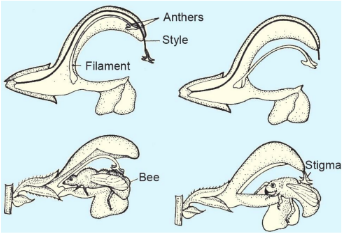Entomophily MCQ - Practice Questions with Answers
Edited By admin | Updated on Sep 18, 2023 18:34 AM | #NEET
Quick Facts
-
18 Questions around this concept.
Solve by difficulty
During the act of pseudocopulation in Ophrys, the insect picks up
What insects pollinate?
Which of the following plant show pseudocopulation?
Pollination in water hyacinth and water lily is brought about by the agency of
Which of the following are the important floral rewards to animal pollinators?
Concepts Covered - 1
Insect Pollination
- Insect pollination is also termed as entomophily.
- Insect-pollinated flowers are large, colourful, fragrant and rich in nectar.
- A number of flowers are clustered into an inflorescence to make them conspicuous.
- Flowers have nectar glands and are highly fragrant to attract insects.
- The surface of pollen grains is sticky due to the exine layer and stigma is sticky due to the mucilaginous layer.
- Nectar and pollen grains are floral rewards for the insect pollinators.
- In some species, floral rewards are to provide a safe place to lay eggs, e.g., for the tallest flower of Amorphophallus (about 6 feet in height).
Special Adaptations:
1. Salvia: Turn Pipe or Lever Mechanism:
- Salvia has got a bilabiate corolla with two fertile epipetalous stamens.
- The stamens and pistil remain hidden under the upper lip.
- The flower is protandrous and the short epipetalous filament of each stamen is connected to the peculiar distractile connective which is long and lever-like, its two unequal arms separating the two anther lobes.
- The basal lobe of the anther is sterile while the upper lobe is fertile.
- A slight pressure on the lower anther lobe brings the upper lobe down.
- Salvia is bee-pollinated.
- Bees alight on the lower lip of the corolla and enter the flower to reach the nectary at the end of the corolla tube.
- In so doing, they push against the united lower anther lobes thereby bringing down the fertile anther lobes which dust the bee’s back with pollen.
- When the pistil of the flower becomes ripe, the stigmas protrude out of the upper lip so that any bee entering the flower brushes against the stigma thereby pollinating it with pollen already on its back.

2. Ficus carica and other Ficus spp. of Moraceae
- Flowers of Ficus plants are enclosed within the hollow pear-shaped hypanthium inflorescence.
- There is a narrow orifice for entering the receptacle within which there are three types of flowers male, female and gall.
- Figs are pollinated by the gall wasp (Blastophaga) which crawls into the receptacle and lays eggs inside the ovules of the ‘gall flowers’ which it can easily reach by its ovipositor because of the shortness of the style.
- The eggs develop larvae which feed on the ovules and form galls.
- After passing the pupa stage, the larvae develop into mature wasps and crawl out of the fig.
- In so doing they brush against the male flowers near the orifice carrying away pollen on their bodies.
- These pollen-laden insects then enter fresh figs where they pollinate the long-styled female flowers and lay eggs within the ‘gall flowers’ in their turn.
3. Pseudocopulation in Ophrys
- Orchids attract insect pollinators by modifying their labellum (one of the petals) to roughly resemble a bee or a wasp.
- Short-sighted male insects mistake the labellum for a female, land on it, and try to copulate.
- Their efforts are of course fruitless, but this is the way the orchid gets itself pollinated.
- During the act, the insect dislodges the pollinia (a mass of pollen grains stuck together) from the orchid, which sticks to its body, ready to pollinate the next orchid on which it lands.

4. Yucca:
- A similar relationship exists between a species of moth and the plant Yucca where both species – moth and the plant – cannot complete their life cycles without each other.
- The moth deposits its eggs in the locule of the ovary and the flower, in turn, gets
- pollinated by the moth.
- The larvae of the moth come out of the eggs as the seeds start developing.
Study it with Videos
"Stay in the loop. Receive exam news, study resources, and expert advice!"

